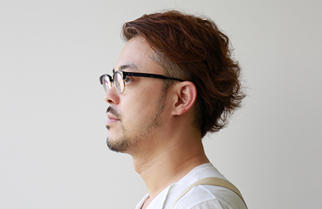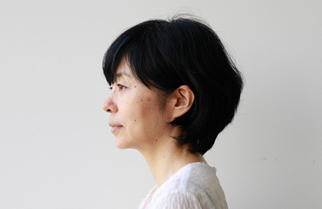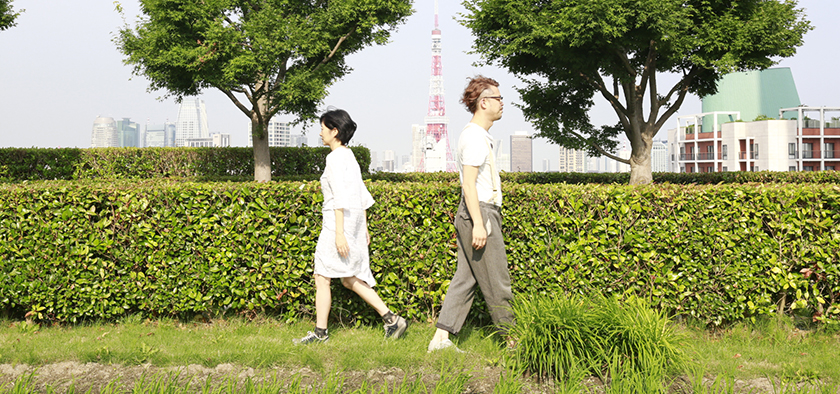
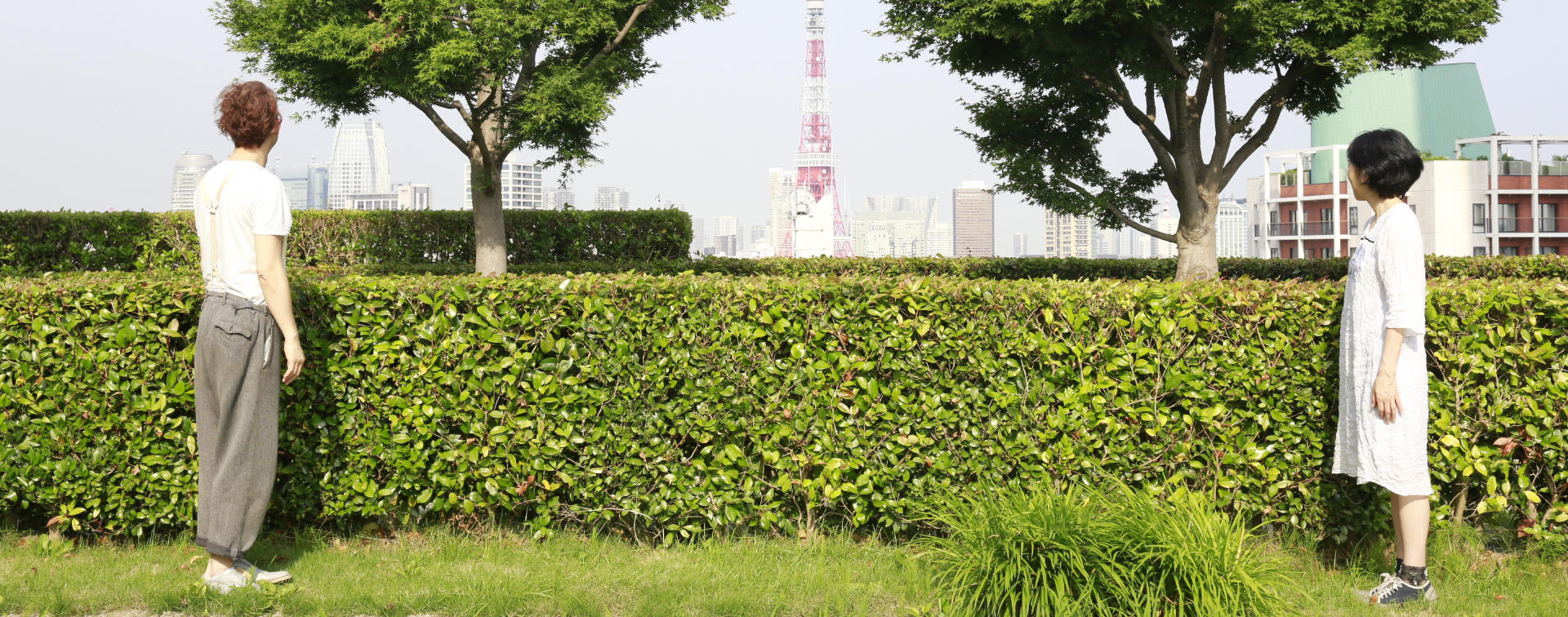
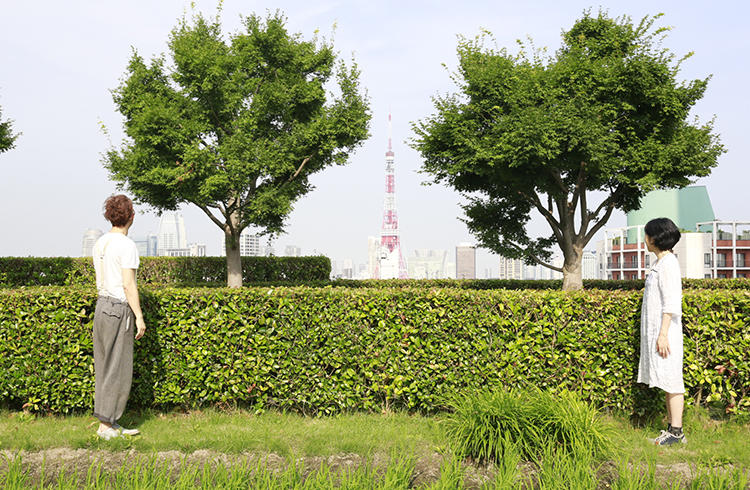
Not changing anything, but telling people about the fun of Roppongi
“Roppongi Future Cards” for recommending places
Before becoming independent, Ryosuke Uehara and Yoshie Watanabe were both employed at design company DRAFT, working on numerous advertising projects and designing products for the brand "D-BROS". Currently, Uehara and Watanabe work as art directors for companies, fashion brands and "select shops", and are engaged in a wide range of creative activities such as branding, product design, fashion design and making visuals and application software. On the day of the interview, we had a shooting session for the photographs to be used for the interview article; the venue was the Roppongi Hills rooftop garden which Watanabe-san said she had always wanted to visit. At the beginning of the interview, we asked the two about ideas for changing Roppongi into a nicer area, and got a most unexpected response from Uehara-san.
No need to change anything in Roppongi
UeharaYou have these "Roppongi Future Talks" but I wonder what exactly is dissatisfying about Roppongi. I don't think there's any need to change things at all; things are fine as they are, aren't they? (laughs) Until recently, I used to live in nearby Minami-Azabu and I like Roppongi as it is. There are art museums and places to shop, and it's an area where interesting things always seem to be happening. All kinds of people come here, and all kinds of different shops are huddled together - it's intriguing. In the past, AXIS was just about the only place for anything related to design, but after Roppongi Hills and Tokyo Midtown were built, things have really changed.
WatanabeI first came to Tokyo for leisure when I was a third-year university student. I was clueless, but my friends told me about the Almond café in Roppongi. At that time, there seemed to be a lot of foreigners in the streets luring customers.
UeharaI was about 22 when I first came to Roppongi and I also waited for my friends in front of Almond. (laughs) I had no purpose in Roppongi and it seemed like a somewhat scary place.
WatanabeThis was years ago, but I once worked at a company in Roppongi for about 10 months. During that time, I often went to the Chinese restaurant Kohien which is famous for its chicken broth noodle soup and to Moti, the Indian curry restaurant. AXIS was also a place I frequently visited: it seemed to be must-go-to- place for interior items.
UeharaI still often go to the Living Motif shop at AXIS. It's a convenient place; whenever I go there with the intention of buying something like a frying pan or an iron, I always find something good. And at the year-end, I sometimes drop by Tokyo Midtown to buy food and kitchen tools and other things, and come home by taxi carrying huge bundles.
WatanabeAnd in the New Year, you bring us curry that you've made. (laughs) These days, I come to Roppongi for its art museums or movie theaters; there's little else that draws me here. I visit the Mori Art Museum, 21_21 DESIGN SIGHT, Suntory Museum of Art and The National Art Center, Tokyo. When there are interesting exhibitions going on at the same time, I sometimes visit two or more.
UeharaWorkwise, we were given the opportunity to show our works at the "Chocolate" exhibition at 21_21 DESIGN SIGHT. Recently, we also did an exhibition at Tokyo Midtown Design Hub called "The Design Batons - Future-minded artists sharing their dreams."
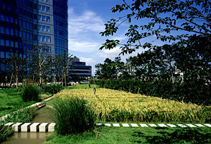
Roppongi Hills rooftop garden
A roof garden 45 meters from the ground at the Keyakizaka complex of Roppongi Hills. Covering roughly 1,300 square meters, the garden is surrounded by trees and is themed on the four seasons of the year. It has a path lined with cherry blossom trees, a pond, a paddy field and a vegetable garden. Rice and vegetables are actually grown and harvested here. The garden is normally closed to the general public.
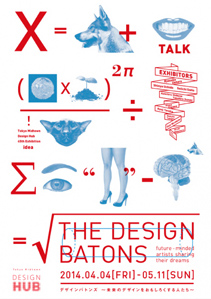
The Design Batons - Future-minded artists sharing their dreams.
A joint exhibition held at Tokyo Midtown Design Hub from April to May, 2014. Designers noted for their current activities became "curators" and chose other designers who they think are linked to the future, holding one-on-one talks with them. Uehara talked with musician Umitaro Abe.
Cooperating with the craftspeople to sell products
UeharaSince we're talking about the area of Roppongi today, I would like to mention a project we're recently doing which is involved with towns and regions. We've set up a brand called "KIKOF" with craftspeople in Shiga Prefecture. In the neighborhoods around Lake Biwa in Shiga Prefecture, there are many craftspeople making mainly Buddhist altars and Buddhist objects. The industry is not as vibrant as it used to be, but there is splendid technology.
There's a project set up by Professor Noriji Sato at Ritsumeikan University called the "Mother Lake Products Project" which makes traditional handcrafts suited for contemporary lifestyles. We thought that maybe KIGI could do something together with the craftspeople who are members of this project, and so we established KIKOF.
WatanabeThere are currently six groups making pottery, hemp, Japanese "chirimen" crepe, woodcraft, lacquerware, and prayer beads. KIKOF's first batch of products will be the Shigaraki pottery by (pottery maker) Marushi Seito-san which are scheduled to be sold soon.
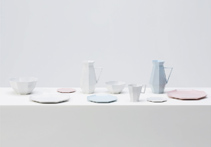
KIKOF
A brand set up by KIGI and craftspeople of the "Mother Lake Products Project" to sell products they have developed together. Ceramics made by Shigaraki pottery maker Marushi Seito are scheduled to be put on the market in the summer of 2014. "Paper forms that can be made from paper" is the catchphrase of the ceramics which are extremely thin and light.
http://www.kikof.jp
UeharaIn this kind of project, we can make ourselves useful by creating a brand. As product designers, we make things, but we also do graphics, so we are sort of like advertising people. We don't want to just advertise though - we want to make good products first and then use a system where we can tell people about the products in a manner that is natural and not pushy.
WatanabeSo we're not saying, "We did the designing, so please do the selling!" We want to work together in selling the products.
UeharaThis isn't just about agreeing on the fees for designing; we also make decisions on matters like how to divide the money, and we keep everything clear and open. We need to have a fair relationship with the craftspeople, so we show them numbers that no one would find problems with. We need the craftspeople to say, "This certainly is very equal."
WatanabeWe also share the burden of risk. If the products find wider demand, then we will eventually make profit. The aim is not to just make profit. We all love making things and we have respect for culture. That's why we get on with each other.
UeharaIn the beginning though, there were so many different materials we were dealing with, and there was a sense of uncertainty. In our usual work, we first come up with the ideas for products, and then we find the right craftspeople, and then we find the right factory to make them. That usual flow was completely reversed with this project.
WatanabeThe notion that most people have is that pottery from Shiga Prefecture means Shigaraki pottery, and Shigaraki pottery means raccoon dog ornaments. So at first, that kind of thinking baffled us...(laughs)

Holding exhibitions from the desire to make things
UeharaWe left the design company DRAFT and became independent about two and half years ago. I was thinking about what an ideal company of my own would be like, and what I could do make it a reality. We could have made a new division within DRAFT or done work overseas. We didn't actually want to quit, did we?
WatanabeNo. I never imagined I would become independent. I didn't have enough time to draw pictures, so I was wondering if I could go to work three days a week, even if for half the wages. We still do work for D-BROS, and we sometimes ask people at DRAFT to be designers and producers for some of our projects, so I think we became independent in the best possible way.
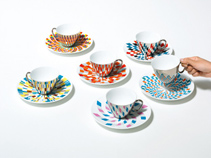
D-BROS
A brand set up by graphic design company DRAFT in 1995 to sell products such as stationary and tableware. Uehara and Watanabe still serve as the brand's art directors. In 2011, the brand's first shop was opened.
http://www.d-bros.jp
UeharaIn some ways, work has expanded and become easier for us.
WatanabeI think if we had stayed with the company, we may not have been able to do some of the things we are doing now - like making and selling products with the craftspeople of Shiga Prefecture, or making clothes with Hobonichi-san for CACUMA. And we do a lot of exhibitions now, don't we?
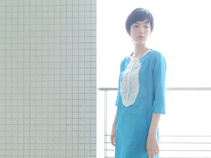
CACUMA
A clothing brand set up by Yoshie Watanabe in 2013. The clothes, designed by Watanabe, are sold on the "Hobo Nikkan Itoi Shimbun" website. Watanabe's illustrations are printed or embroidered dresses, blouses and skirts which have been designed with wearer comfort in mind.
http://cacuma.com
UeharaBefore, we wouldn't have been able to do these things for fear that people would think we weren't working hard enough for the company. Actually though, we discreetly held exhibitions anyway. There was a time when I wrote a series for the "Ryuko Tsushin" magazine; I painted my face black and pretended to be Indian, but I was found out half-way through the series.
WatanabeExhibitions are time-consuming, and it's quite difficult to balance that with work. But we really wanted to hold them, so a little bit of fuss would arise each time.
UeharaWe hold exhibitions whenever we get the urge make something. When you design things, you inevitably face all kinds of restrictions, and an expression or idea that was originally edgy sometimes loses its edginess and become rather round. Our exhibitions are often driven by our desire to see what our works would look like if there were no restrictions.
Graphics alone may not liven up the streets
WatanabeBy the way, do you have any ideas for Roppongi?
UeharaAs I said earlier, I wonder why we are holding these "Future Talks." I'm satisfied with Roppongi as it is. But apparently everyone wants to do something about Roppongi's future.
WatanabeThey want to make it better. For me, Roppongi is about art museums, so I'm happy as long as there are always interesting exhibitions going on, and interesting movies playing. Actually, come to think of it, it would be nice if there was a pleasant road connecting all four art museums.
I think it's rare that so many grand art museums are gathered in one place as in Roppongi. But it's very difficult to get to Roppongi from the National Art Center, Tokyo. If all four art museums were connected to each other in a nice way, I think more people would visit two museums or more. Since we are designers, perhaps we could do something for Roppongi by designing things like billboards and signs?
UeharaI am hesitant about adding anything more to this area...
WatanabeHmmm. Well, maybe graphics alone won't help to make the streets more fun.
The unrecognized appeal of Roppongi
UeharaI also often visit Tokyo Midtown and Roppongi Hills, but they are farther apart than you'd expect, so I often end up catching a taxi, and that is a problem. (laughs) As Yoshie-san has pointed out, the space between Midtown and Hills may be dull... But I myself feel it's interesting that the shady establishments located around the elegant art museums and the shopping malls form a contrast. The foreigners walking by and the rather frightening atmosphere of Roppongi are also appealing factors.
When you think about it, even the Imoarai-zaka slope is attractive, and Tsutaya Tokyo Roppongi is nice. I sometimes use the sauna at the top of Roi building and often go to AXIS. Roppongi is a small area and the number of things you can do here is limited. The address of the area beyond Tsutaya is not Roppongi, but Azabu-Juban. And it's no longer Roppongi when you go beyond AXIS.
WatanabeYou really do walk end to end. (laughs)
UeharaI do go to quite a lot of places. There are times when I walk down a backstreet and find myself in a residential area; sometimes I get lost and discover a peculiar establishment. The Chinese restaurant at the Roppongi Rokuchome intersection serves delicious food. The "Herb Tea Cafe Key Roppongi" which I went to the other day is also great. They have a wide range of teas and they tell you in detail about their benefits.
WatanabeLooking at it that way, I realize that Roppongi has a lot to offer. But I think people still have the image of the old Roppongi in their minds, so it's hard to recognize its true appeal.
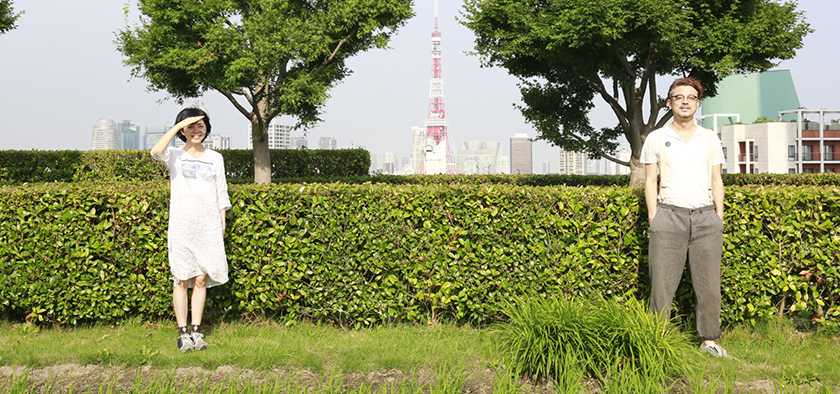
Redesigning a handful of establishments
WatanabePerhaps if each one of the establishments, including the trendy ones and the untrendy ones, all became more charming, people who have stayed away before will begin coming to Roppongi?
UeharaI doubt it. Things are fine as they are now; if I were told to spend a whole day in Roppongi, I will be able to enjoy myself. I'd like to make notices or invitation cards for such a day. In fact, I'd be happy to do a tour, meeting at some place first thing in the morning. The tour will be limited to one or two participants. (laughs)
We would take a bath at the top of the Roi building and refresh ourselves, and then have a massage at Bear Hug above Almond. An interesting spot is the restaurant (Brasserie Paul Bocuse) on the third floor of the National Art Center, Tokyo. It's not as crowded as you would expect, and the sunlight is lovely. We would end the tour at the Herb Tea Cafe. None of the places are extremely cool, but they all have an interesting aspect.
WatanabeMaybe the places that are untrendy can be left as they are, but it might be a good idea to select a handful of places that could do with some sprucing up and fix them up a bit - doing things like designing nice-looking menus.
UeharaIn that case, we should have a person in charge of sales to do the persuading. The person would knock on the door of each establishment and say, "We propose making an improvement to your menu.." If designers go directly to the establishments, things will get complicated, so I think we should ask the people of Roppongi Future Talks to do this!
WatanabeThe International House of Japan is a delightful place - though I've only been there to attend weddings. I wish the menus were better designed.

International House of Japan
A non-profit organization set up in 1952 with the aim of promoting international cultural exchange. It has accommodation facilities and halls as well as a garden which has been designated by Minato Ward as a place of scenic beauty. The old part of the building was jointly designed by architects Kunio Maekawa, Junzo Sakakura and Junzo Yoshimura.
UeharaThe menu at the sauna at the Roi building could do with some redesigning too. But if the place became too stylish, many people might come, and that would be a problem for me. (laughs)
The weird and interesting streets of Japan
WatanabeLast year I went to Paris. The airport had been renovated and everything was snazzy, from the signs to the leather chairs. When I came back to Narita airport, I was so disappointed. I've never thought it was a great place, but it seemed so uninteresting, and the difference was striking. This is not a matter related to Roppongi, but Narita is the gateway to Japan, so I hope they do something about it by the time the Olympics are held.
UeharaI went to Switzerland recently and was impressed. All the towns are immaculate.
WatanabeThe nature in Switzerland is amazing and there are exquisite designs, and it's as if stress does not exist there. From the pamphlets lined up at a countryside station to the buses and bus stops, everything is beautiful. But since Switzerland is so lovely, one does not feel the need to pursue anything more there... so perhaps in a way, it lacks interestingness.
In Japan, there are some weird-looking streets, but they apparently ended up that way after people tried to do something interesting. There are times when I feel tired with the messiness, but the chaotic streets were made from a strong yearning and thirst, and maybe that is what the interestingness of Japan is about.
Cards that tell you how to spend a day in Roppongi
UeharaI just had an idea. How about having a person like a tipster at the horse races selling bags with cards inside them? On the bag is a picture of me or someone else who knows a lot about Roppongi, and people pick the cards from it like "omikugji" (fortunes written on strips of paper). The cards will tell people to go certain places, saying things like, "Go first to so-and-so, and then go to so-and-so." They will be "Roppongi Future Cards" - giving people information on recommended courses.
WatanabeI see. So the "tipsters" will be giving tips on people's futures. Isn't that a bit like the Roppongi Future Talks' 6 x 6 ROPPONGI DESIGN & ART MAP?
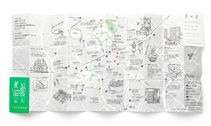
6×6 ROPPONGI DESIGN & ART MAP
A map of Roppongi made by Torafu Architects as part of a Roppongi Future Talks project; this was the second time that an idea given by an interviewed creator was actually realized. Based on six themes such as "food" and "nightspots", six groups of creators including Kundo Koyama gave recommendations on places to go in Roppongi.
UeharaWhat I have in mind is not genre-based, but a chronological schedule for spending a day. So if I were the guide, I would recommend the kind of course I just told you about, and if we asked Kundo Koyama-san to be the guide, he would surely think of something interesting.
WatanabeThere might be couples who are wondering where to go, so you could give them date ideas.
UeharaWe should also have courses for people coming alone. It would be good to do this like an event, deciding on a certain date like August 1. With a fixed date, it's possible to give specific instructions like "Watch this movie" or "Go to this exhibition", and arrangements could be made like having special alcohol served at restaurants.
WatanabeIt would be nice to have different versions made by different creators; people would be able to learn about the tastes of the creators and what kind of things they find interesting. Maybe if we did this, people will rush to buy certain products and make long lines at the same shops.
UeharaIt wouldn't do for products to be out of stock, so I suppose we should hold limited sales a little at a time.
Editor's thoughts
After the interview, we took a taxi to Roppongi Hills for the photo session. Uehara-san gave directions to the driver to pass through alleyways we did not know. Uehara-san is an impressive expert on Roppongi, but he told us that it was his first time to enter the rooftop garden. Incidentally, the photographs of Uehara-san and Watanabe-san contain a hint to their unit name "KIGI": in the background are "kigi" (Japanese for trees). (edit_kentaro inoue)




